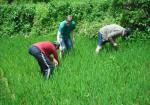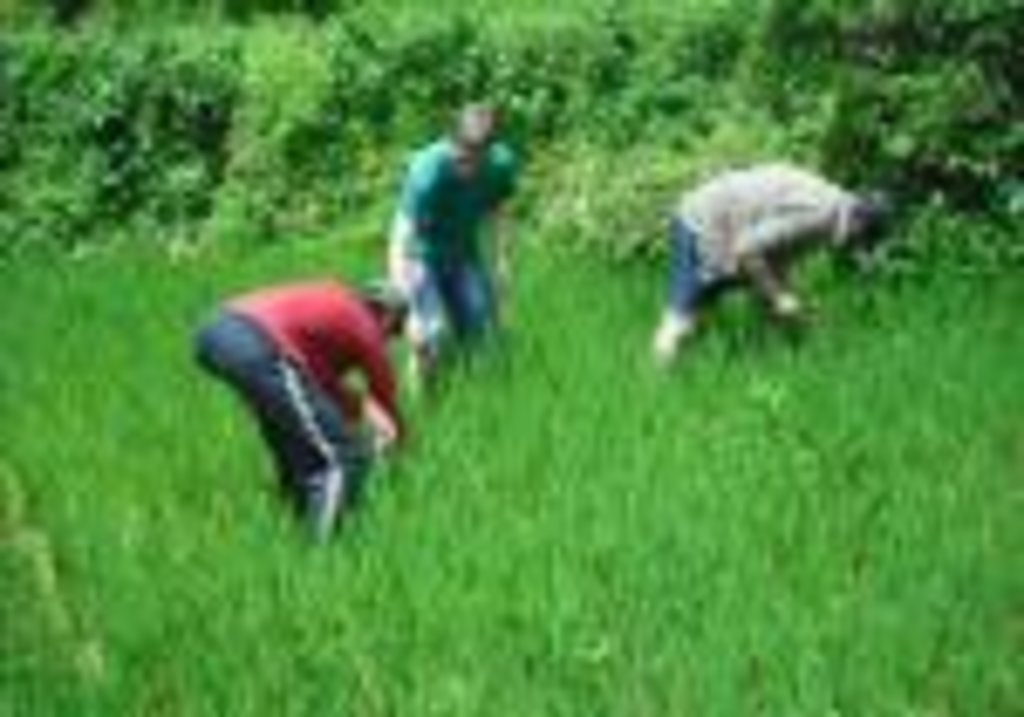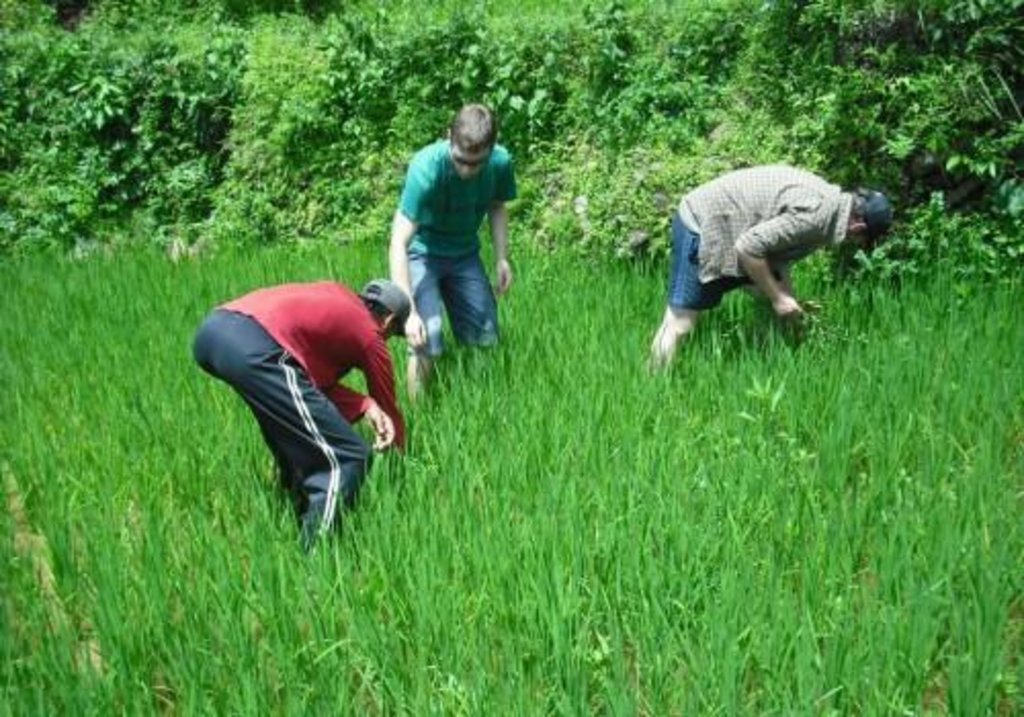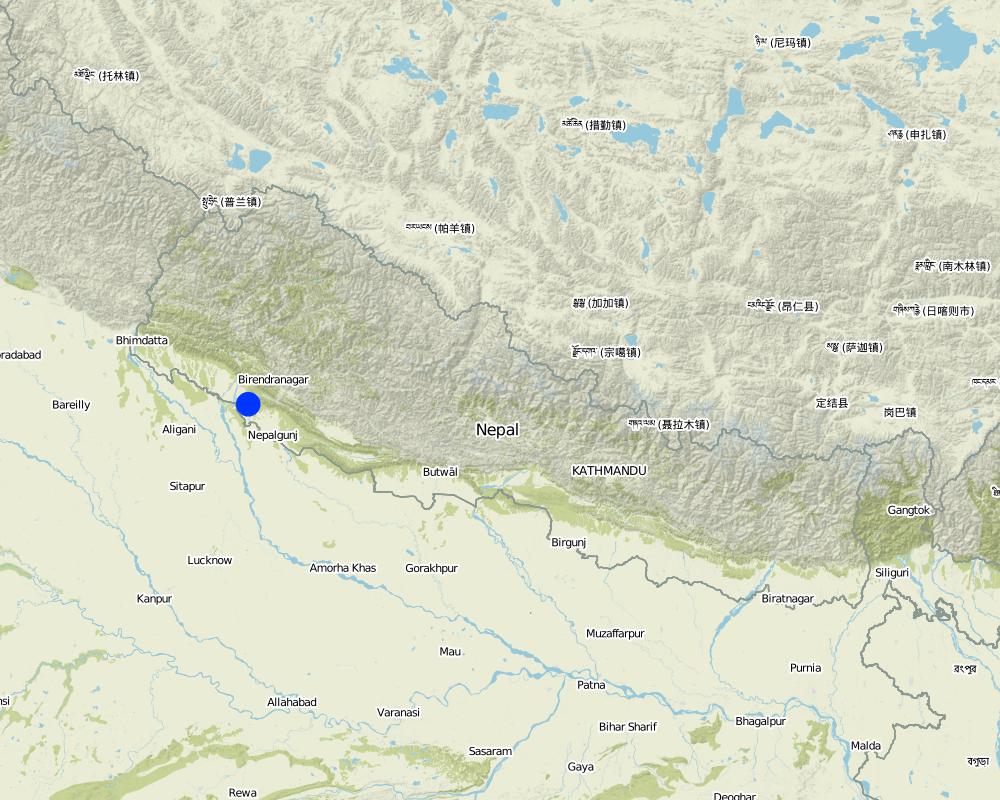Promotion of Sesbania species(as green manures for rice cultivation) [Népal]
- Création :
- Mise à jour :
- Compilateur : Sabita Aryal
- Rédacteur : –
- Examinateur : Fabian Ottiger
Dhaincha Prabardhan
approaches_2483 - Népal
Voir les sections
Développer tout Réduire tout1. Informations générales
1.2 Coordonnées des personnes-ressources et des institutions impliquées dans l'évaluation et la documentation de l'Approche
Spécialiste GDT:
Acharya Shiva
Local farmer Gumi-3 Surkhet,Nepal
Népal
Spécialiste GDT:
Regmi Dambar
Local farmer Gumi-3 Surkhet,Nepal
Népal
Spécialiste GDT:
Gurung Thek
Local farmer Gumi-4, Surkhet,Nepal
Népal
Nom du ou des institutions qui ont facilité la documentation/ l'évaluation de l'Approche (si pertinent)
Kathmandu University (KU) - Népal1.3 Conditions relatives à l'utilisation par WOCAT des données documentées
Le compilateur et la(les) personne(s) ressource(s) acceptent les conditions relatives à l'utilisation par WOCAT des données documentées:
Oui
2. Description de l'Approche de GDT
2.1 Courte description de l'Approche
Green manure-It is a way of adding nutrients and organic matters to soil by incorporating green manure plants which include both leguminous or non-leguminous plants. Sesbania, also known as Dhaincha, i.e. a diverse and versatile genus belonging to the family Fabaceae,which is soft,woody,annual or short lived perennial;primarily used as green manure between rice crops or as an intercrop in transplanted rice.
2.2 Description détaillée de l'Approche
Description détaillée de l'Approche:
Aims / objectives: -Leguminous green plants like Sesbania can fix atmospheric nitrogen in the form that plant can use.
-It helps to improve the soil structure as incorporating it into the soil adds organic matterr (biomass).
-The Sesbania species has high water-logging tolerance which prevents the crop from losing its nutrient content.
Methods: In nepal,institutions like NARC and research programs like Rice Research program has actively promoted Sesbania species. Dr. Bhola man singh basnet of Nepal Agriculture Research council(NARC),khumaltar has extensively carried out his research on green manure using Sesbania, which is called locally as Dhaincha.
The Hardinath Agriculture Farm in Dhanusha,now National Rice Research Program, practiced Sesbania cannabina, dhaincha as pre-rice manure annually in 20 ha for more than 20 years.
Green manure technique is an indigenous practice mainly in the foothills, middle mountains region and central terai of nepal-dhanusha,parsa,bara and Rautahat district.
Stages of implementation: Sesbania is sown before rice is planted.Sow the Sesbania seed densly and lightly cover the seed with soil.Sesbania will grow faster if the soil is kept moist.After 4-6 weeks sesbania will be 18-36 inches tall at ground level and plough in as the paddy are prepared for planting rice.
Seed production process;
Transplant a few of the largest,thickest,healthiest plant into the edges of paddy space at 2 metre intervals along the terrace edges.Seed will be ready after 6 -7 months.This can be used as seed for green manure next year.
Role of stakeholders: Government;
-Institutional roles; NARC, HAF -DDC-Municipality-VDC
Private sectors;
-Desigining policies.
Other important information: -Sesbania species can be grown even under adverse conditions of drought,waterlogging,salinity,etc.
-optimum time of Daincha seed production is the middle of March until the end of May .
-Experiment conducted at several research stataions showed that green manureing with dhaincha in rice increased the grain yields by about 20-25 percent(Pre rice green manure-a success story,B.H.S Basnet,NARC)
2.3 Photos de l'approche
2.5 Pays/ région/ lieux où l'Approche a été appliquée
Pays:
Népal
Région/ Etat/ Province:
Nepal
Autres spécifications du lieu :
Surkhet
Map
×2.7 Type d'Approche
- traditionnel/ autochtone
2.8 Principaux objectifs de l'Approche
The Approach focused mainly on SLM with other activities (Sesbania species increases nutrient content of the soil,due to its water logging tolerance and also increases the fertility,biomass production in the fields as well as nitrogen content of the soil by fixing large amount of Nitrogen.)
-Increase the nutrient in the soil due to its water logging tolerance and thus increases the fertility and productivity.
-Also reduce the need of artificial fertilizers
The SLM Approach addressed the following problems: Low knowledge about the green manuring among people because of which they were lured towards more use of particles and fertilizers.
Lack of improved seeds of green manure(plants).
2.9 Conditions favorisant ou entravant la mise en œuvre de la(des) Technologie(s) appliquée(s) sous l'Approche
disponibilité/ accès aux ressources et services financiers
- entrave
-Improved and large seeds of green manure are costly.
-This can be reduced if we can make these seed locally available at subsidized rate.
Treatment through the SLM Approach:
cadre juridique (régime foncier, droits d'utilisation des terres et de l'eau)
- favorise
The existing land ownership, land use rights / water rights moderately helped the approach implementation: There was a bit hindrance.Seed cultivation requires both land use and irrigation system.
connaissances sur la GDT, accès aux supports techniques
- entrave
-People were found unaware of the proper and new techniques of manuring.
Treatment through the SLM Approach: -Provide necessary information and conduct programs at local/regional level.
autre
- entrave
The species shows better growth and higher biomass yield in the sandy clay than in heavy clay soil.
Treatment through the SLM Approach: The areas with sandy clay loam should be identified if we are to except a high crop yield.
3. Participation et rôles des parties prenantes impliquées dans l'Approche
3.1 Parties prenantes impliquées dans l'Approche et rôles
- exploitants locaux des terres / communautés locales
Farmers community
Men were involved more, because of the hard work in the field.. Many people are using the green manure technique to increase the crop yield but no any incentives and support has been provided by government institutions targeting the socially and economically disadvantaged groups.
- gouvernement local
Hierarchy;District Development comittee-Municipality-VDC
- gouvernement national (planificateurs, décideurs)
Ministry of agriculture
3.2 Participation des exploitants locaux des terres/ communautés locales aux différentes phases de l'Approche
| Participation des exploitants locaux des terres/ communautés locales | Spécifiez qui était impliqué et décrivez les activités | |
|---|---|---|
| initiation/ motivation | auto-mobilisation | Farmers |
| planification | interactive | Involvement of individuals (farmers) at the begining.Gradually supported by many institutions. |
| mise en œuvre | auto-mobilisation | Sesbania is a local species available in Nepal since 1960 and used as green manure by farmers land users to increase productivity and field of crops. |
| suivi/ évaluation | passive | Gradual progress and support from government and institutions. |
| Research | soutien extérieur | Research being carried by institutions, on nutrient content and new species of green manure plant. |
3.4 Prises de décision pour la sélection de la Technologie/ des Technologies
Indiquez qui a décidé de la sélection de la Technologie/ des Technologies à mettre en œuvre:
- principalement les exploitants des terres soutenus par des spécialistes de la GDT
Expliquez:
Green manuring using Dhaincha is an indigenous practice which is currently supported and motivated by many institutions.
Decisions on the method of implementing the SLM Technology were made by by land users* alone (self-initiative / bottom-up). Due to the dissatisfaction by the use of the fertilizers(artifical) land users themselves initiated the approach for better production.
4. Soutien technique, renforcement des capacités et gestion des connaissances
4.1 Renforcement des capacités/ formation
Une formation a-t-elle été dispensée aux exploitants des terres/ autres parties prenantes?
Non
4.2 Service de conseils
Les exploitants des terres ont-ils accès à un service de conseils?
Oui
Décrivez/ commentez:
Name of method used for advisory service: Participatory community-based approach.; Many people including farmers, land users participate,discuss and conclude about the way of practicing of green manuring.
Advisory service is quite adequate to ensure the continuation of land conservation activities; Government and institution are the one that make the seeds of green manure plant available to the local farmers.So their contribution and continuation of land conservation activities cannot be neglected.
4.3 Renforcement des institutions (développement organisationnel)
Des institutions ont elles été mises en place ou renforcées par le biais de l'Approche?
- oui, modérément
Spécifiez à quel(s) niveau(x), ces institutions ont été renforcées ou mises en place:
- local
Précisez le type de soutien:
- renforcement des capacités/ formation
Donnez plus de détails:
Documentation of the approach provide training to the land users about green manure techniques.
4.4 Suivi et évaluation
Le suivi et l'évaluation font ils partie de l'Approche? :
Oui
Commentaires:
bio-physical aspects were regular monitored by government through observations; indicators: Nutrients like N,P,K are monitered at a regular basis by and institutioons like NARC,HAF.government land users(farmers)
economic / production aspects were regular monitored by land users through observations; indicators: crop yield per hectare.
There were few changes in the Approach as a result of monitoring and evaluation: seed varities of sesbian species shows better growth in sandy clay than heavy clay soil. so, the soil type needs to be considered.
4.5 Recherche
La recherche a-t-elle fait partie intégrante de l’Approche?
Oui
Spécifiez les thèmes:
- écologie
Donnez plus de détails et indiquez qui a mené ces recherches:
Research was carried out on-farm
5. Financement et soutien matériel externe
5.1 Budget annuel de la composante GDT de l'Approche
Si le budget annuel précis n'est pas connu, indiquez une fourchette:
- < 2 000
5.2 Soutiens financiers/ matériels fournis aux exploitants des terres
Les exploitants des terres ont-ils reçu un soutien financier/ matériel pour la mise en œuvre de la Technologie/ des Technologies?
Oui
Si oui, spécifiez le(s) type(s) de soutien, les conditions et les fournisseurs:
Governmental Aid.
5.3 Subventions pour des intrants spécifiques (incluant la main d'œuvre)
Commentaires:
Green manure seeds are distributed by the government to the local bodies;from where the seeds are sold to the land users/farmers.
5.4 Crédits
Des crédits ont-ils été alloués à travers l'Approche pour les activités de GDT?
Oui
6. Analyses d'impact et conclusions
6.1 Impacts de l'Approche
Est-ce que l'Approche a aidé les exploitants des terres à mettre en œuvre et entretenir les Technologies de GDT?
- Non
- Oui, un peu
- Oui, modérément
- Oui, beaucoup
- it increases the fertility and nutrient content of the soil due to its water logging tolerance. -Helps control soil erosion. -It also improve the quality of soil and crops.
Est-ce que l'Approche a autonomisé les groupes socialement et économiquement défavorisés?
- Non
- Oui, un peu
- Oui, modérément
- Oui, beaucoup
Poor farmers earn quite a good sum due to increase in yield and productivity by using sesbania as green manure.
The problem is likely to be overcome in the near future.
Did other land users / projects adopt the Approach?
- Non
- Oui, un peu
- Oui, modérément
- Oui, beaucoup
NARC which provide training as well as focus on the practice of green manuring which help all the villagers to get benefitted.
Did the Approach lead to improved livelihoods / human well-being?
- Non
- Oui, un peu
- Oui, modérément
- Oui, beaucoup
using sesbania species as green manure increases the production of rice in the farms. also reduce the expenses for buying of artificial fertilizers from suppliers.
Did the Approach help to alleviate poverty?
- Non
- Oui, un peu
- Oui, modérément
- Oui, beaucoup
increase the productivity and crop yield which lead to the rise in economic status of people by selling the grains on market.
6.2 Principale motivation des exploitants des terres pour mettre en œuvre la GDT
- augmenter la production
increase in the crop productivity.
6.3 Durabilité des activités de l'Approche
Les exploitants des terres peuvent-ils poursuivre ce qui a été mis en œuvre par le biais de l'Approche (sans soutien extérieur)?
- oui
Si oui, décrivez de quelle manière:
Since it is easy and natural method to increase the fertility of the soil,farmers can be benifited..it only requires the basic knowledge about the seasons and seeds(improved) so it can be easily implemented.
6.4 Points forts/ avantages de l'Approche
| Points forts/ avantages/ possibilités du point de vue de l'exploitant des terres |
|---|
|
-if some species of sesbina like Sesbania cannabina are established as an intercrop in rice. -During short Day season,vegetative growth of the plant is reduced due to early flowering. -Many Sesbania species are being over ploited. -Improved seeds of sesbian sp, are costly and this technique requires a lot of labour work, people are in more favour of artificial chemical fertilizers. (How to sustain/ enhance this strength: -it can be suppressed by the rice if sown 30-60 days after crop. -These sp. should be sowed in the middle of March to end of vegetables growth. -Attention must be given to the conservation and proper utilization of these important plant species. -Government /local bodies should make it available at cheaper rate and encourage people to revive interest in green manures.) |
| Points forts/ avantages/ possibilités du point de vue du compilateur ou d'une autre personne ressource clé |
|---|
|
-Increase the fertility of the soil. -it can help to increase the biomass in the soil. -Increases microorganisms and their activity in the soil. (How to sustain/ enhance this strength: They can be enhanced if the present trend of exploiting green manuring plants are changed to develop their production on a sustainable basis.) |
7. Références et liens
7.1 Méthodes/ sources d'information
- visites de terrain, enquêtes sur le terrain
- interviews/entretiens avec les exploitants des terres
7.2 Références des publications disponibles
Titre, auteur, année, ISBN:
Regenerative Agriculture Technologies for the Hill farmers of Nepal,'Nepal Rural Re-construction Association.The Farmers Handbook,'The Field' Ms. Hommaya GurungGreen Manure Production System For Asian Ricelands, J.K Ladha
Liens et modules
Développer tout Réduire toutLiens
Aucun lien
Modules
Aucun module trouvé





